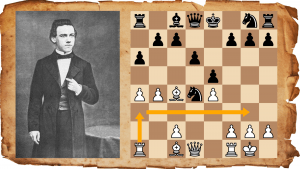
Why You Should Move Your Queen As Early As Possible!
One of the first things everyone learns playing chess is that the queen is the strongest piece on the board.
Her power is amazing! She's worth nine pawns; she's majestic, extremely agile and has seemingly unlimited powers. Then, however, comes the big disappointment: It's actually unwise to move the queen early in a chess game.
Don't move the queen too early! Develop your knights and bishops first, occupy the center, bring the king into safety, and only then start thinking about your queen. This is what everyone learns.
Over the years, I've come to realize that this general rule, while useful for beginners, is mostly rubbish. The truth is that most players, even strong ones, don't know how to handle early queen-sorties at all, especially in blitz and rapid games. They don't know how to deal with it, they sometimes don't even take it into account!
I played the following game when I was still a beginning junior player myself, but it made a lasting impression on me.
After the game—which was quite humiliating to me since this was the first game to finish in the entire tournament hall—my opponent told me that the great Mikhail Chigorin once fell into the same trap (Mieses-Chigorin, Ostend 1906) and I felt less bad, but I never forgot the lesson of this game: Sometimes moving your queen early in the game will give you a quick and easy victory!
Ever since, I've been interested in opening lines featuring an early queen move. As Black, I've often played the Scandinavian (1.e4 d5 2.exd5 Qxd5 or 2...Nf6 followed by a later... Qxd5).
As White, I've used the Center Game (1.e4 e5 2.d4 exd4 3.Qxd4) as a dangerous weapon in which Black often had no clue how to handle White's aggressive queen. I've had the following sequence of moves probably hundreds of times in blitz games:
(Interestingly, in the recent World Cup tournament, Evgeny Najer tried 1.e4 e5 2.Nc3 Nf6 3.d4 exd4 4.Qxd4 Nc6 5.Qd3!? in one of his tiebreak games against Anish Giri, the world number-four. Unfortunately, he lost.)
Examples like the one above happen, in fact, quite regularly. You move your queen out early, your opponent wants to "punish" you for it, and thinks he is justified in doing so. After all, only amateurs move their queen early in the game! However, he forgets that chess is still a game of tactics, and that the queen is a powerful tactical piece!
Still don't know what I'm talking about? Take a look at this example, which is pretty well-known, but still makes very regular victims, especially in blitz.
The reason why this trick occurs so often is that Black apparently has done nothing wrong. He's just developed his knights and White has failed to protect his center pawn. How could it be wrong to just capture it?
Well, because the queen is a piece full of tactical energy, that's why! It's worth taking note of this motif if you haven't seen it before, as it features quite regularly in Puzzle Rush!
Here's the quintessential example:
The concept of moving your queen early (even when it doesn't immediately win material) is, of course, fairly uncontroversial in traditional openings such as the Scandinavian and the King's Gambit. A standard line like 1.e4 e5 2.f4 exf4 3.Bc4 Qh4+ comes to mind, where Black immediately forces White to give up the right to castle, although the queen often gets chased away at great expense later on, as in the famous Immortal Game, Anderssen-Kieseritzky, London 1851.
And we all know the Scholar's Mate (1.e4 e5 2.Bc4 Bc5 3.Qh5). I've written about cases where the f7/f2 point is under attack already in a previous article, so I'll skip these ones, even though the temptation to write about the fascinating Hillbilly Gambit (1.e4 c6 2.Bc4!? d5 3.Bb3 dxe4 4.Qh5!), which has been advocated by GM Simon Williams, is hard to resist.
On the other hand, there's also respected positional lines in the Queen's Gambit Declined such as the Cambridge-Springs Defense (1.d4 d5 2.c4 e6 3.Nc3 Nf6 4.Bg5 Nbd7 5.Nf3 c6 6.e3 Qa5) and, currently very topical, the Ragozin Variation, in which White plays an early Qd1-a4+ to disrupt Black's piece coordination. And let's not forget the Classical Variation of the Nimzo-Indian (4.Qc2) either.
Also, there are many openings where the queen moves to the center early in the game because it can't get chased away by a knight anymore, or where an attacking knight can immediately be pinned. In such cases, the queen can actually be very useful and active in the middle of the board. Think of the Alapin Sicilian (1.e4 c5 2.c3 d5 3.exd5 Qxd5), or the Chigorin Defense (1.d4 d5 2.c4 Nc6 3.cxd5 Qxd5 4.e3 e5 5.Nc3 Bb4).
Let's forget about these trivial examples and move on to the more exotic ones. Here's a very nice and surprisingly positional example, which I've once become a victim of myself:
Black also has an even simpler version of this idea, which in my opinion is more interesting than it looks at first sight:
There's an even more fascinating example of a white queen moving to d3 early in the opening. You've probably heard of the Chigorin variation of the French, which starts with 1.e4 e6 2.Qe2!?
As I've recounted in an earlier Chessvibes article (no longer available) about this line, I remember the sense of wonder when I first encountered this weird little queen move. What is White thinking, moving his queen in front of his bishop like that?! Then I saw the name of the players: Chigorin-Tarrasch, St. Petersburg 1893.
This was obviously not just a random move played by an amateur. It was played by one of the greatest players of his day and age!
 '
'
Mikhail Chigorin (1850-1908).
It soon became clear to me what White's idea was all about: preventing d7-d5. After all, if 2...d5, then 3.exd5 and Black can't recapture with the e-pawn, drawing his own queen out in the open. Here is the far-reaching power of the queen in action again. A similar type of preventative action can be seen in the Sicilian Alapin:
Back to Chigorin-Tarrasch. After 2.Qe2, Black proceeded in a different style:
A few games later in their match, Chigorin showed another idea behind White's setup. This time, he didn't aim for a setup with g2-g3, but chose one with b2-b3 instead.
Although these particular lines aren't very popular today, the themes and concepts displayed in them are still very common. Actually, this was one of the first mainstream cases where White played a so-called King's Indian Setup (with g2-g3). And in the French Winawer variation, the idea to move the queen to g4 in order to attack g7, is extremely common:
There's actually an even earlier version of this, which not everybody knows about. It's rather dangerous if you've never seen it as Black:
The idea to grab a pawn on the flank (in this case, g7) has been mirrored as well, of course, and there are many variations where Black has gone on a limb to catch the b2 pawn. The most famous example is surely the infamous Poisoned Pawn variation, favoured by Bobby Fischer and Garry Kasparov, among others. Here it is, in case you've never seen it (which is unlikely!):
There are many similar situations in all kinds of openings. Let me just mention two of them, the first one from the Keres Defense (1.d4 d5 2.c4 Bf5!? 3.Qb3!? which is best met by the surprising counter-strike 3..e5!) and the second from the London System (1.d4 d5 2.Bf4 c5 3.e3 Nc6 4.c3 Qb6, which featured in a game Carlsen-So, Leuven 2017). It goes to show that it's not easy to punish a rampant queen, even if she's moved deep into foreign territory!
We've gone from fairly unusual to pretty standard variations and back. But let's finish on a bizarre note. I'll call this our final category. What do I mean by that? Okay, take a look at the following bullet game, which I played some time ago on Chess.com:
Even though I lost this game even quicker than the one we started this article with, I couldn't help laughing out loud about the "joke" my opponent had pulled on me.
I'm sure there are many more examples where an early queen move has led to a quick victory. We all learn that such moves should be punished, and that it is our duty to do so. But never underestimate the power of the mighty queen! She might trick you and confuse you and lure you into muddy waters. Be warned!

